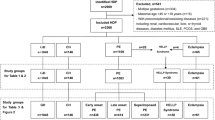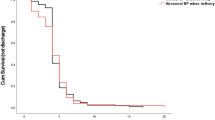Abstract
As there is growing evidence that hypertensive pregnancy disorders are associated with a risk of cardiovascular diseases later, the resolution of hypertension postpartum (PP) is of high clinical significance. However, there is little knowledge about the factors that influence this normalization. The objectives of our study were (a) to investigate whether or not there are differences in the resolution of hypertension between the distinct types of hypertensive pregnancy disorders and (b) to analyse what clinical parameters may determine the resolution pattern PP. In this retrospective study, 52 patients with preeclampsia (PE), seven with HELLP syndrome (haemolysis, elevated liver enzymes, low platelets), 10 with chronic hypertension (CH) and 21 with pregnancy-induced hypertension (PIH) were recruited. The course of the clinical parameters until day 7 PP was documented. Patients with proteinuria (PE/HELLP) showed the highest blood pressure values PP, while patients with PIH and CH showed no blood pressure changes up to day 7 PP. In patients with proteinuric diseases, there was a significantly higher percentage of cases with persisting hypertension at day 3 PP (71% vs 48% PIH/CH group, P<0.05), and even at day 7 PP this percentage remained significantly higher (31% vs 19% PIH/CH group). Our study shows that patients with proteinuric pregnancy disorders have a delayed PP of hypertension. A high percentage of these women are discharged from hospital with persisting hypertension and proteinuria. These observations demand a more specific and long-term PP care for these women.
This is a preview of subscription content, access via your institution
Access options
Subscribe to this journal
Receive 12 digital issues and online access to articles
$119.00 per year
only $9.92 per issue
Buy this article
- Purchase on Springer Link
- Instant access to full article PDF
Prices may be subject to local taxes which are calculated during checkout
Similar content being viewed by others
References
Rodie VA, Freeman DJ, Sattar N, Greer IA . Pre-eclampsia and cardiovascular disease: metabolic syndrome of pregnancy. Atherosclerosis 2004; 175: 189–202.
Wilson BJ, Watson MS, Prescott GJ, Sunderland S, Campbell DM, Hannaford P et al. Hypertensive diseases of pregnancy and risk of hypertension and stroke in later life: results from cohort study. Br Med J 2003; 326: 845.
Sibai B, Dekker G, Kupferminc M . Pre-eclampsia. Lancet 2005; 365: 785–799.
National High Blood Pressure Education Program Working Group on High Blood Pressure in Pregnancy. Report of the National High Blood Pressure Education Program Working Group on High Blood Pressure in Pregnancy. Am J Obstet Gynecol 2000; 183: 1–22.
Samwiil L, Mercer C, Jarrett P, O'Malley S . Blood pressure and urinalysis are often omitted in women who have suffered pre-eclampsia at their six-week postnatal check. Br J Obests Gynaecol 2004; 111: 623–625.
Author information
Authors and Affiliations
Corresponding author
Rights and permissions
About this article
Cite this article
Stepan, H., Nordmeyer, A. & Faber, R. Proteinuria in hypertensive pregnancy diseases is associated with a longer persistence of hypertension postpartum. J Hum Hypertens 20, 125–128 (2006). https://doi.org/10.1038/sj.jhh.1001952
Received:
Revised:
Accepted:
Published:
Issue Date:
DOI: https://doi.org/10.1038/sj.jhh.1001952



